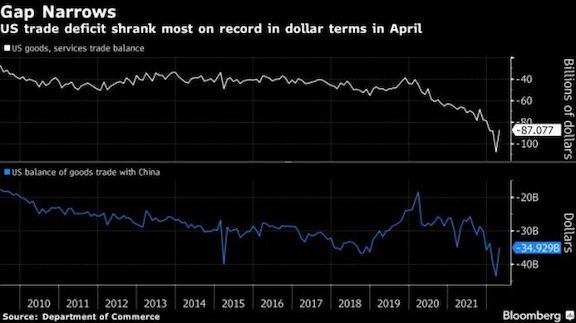The US trade deficit shrunk in April by the most on record in dollar terms, reflecting a drop in the value of imports amid Covid lockdowns in China while exports climbed.
The gap in goods and services trade narrowed $20.6 billion, or 19.1%, to $87.1 billion, Commerce Department data showed Tuesday. The median estimate in a Bloomberg survey of economists called for an $89.5 billion deficit. The figures aren’t adjusted for inflation.
Imports dropped in April as factory activity in China fell to the lowest level since February 2020 amid strict lockdowns to curb the spread of Covid-19. While manufacturing in the country has improved somewhat since, the measures are still straining already-tenuous global supply chains, especially when coupled with Russia’s war in Ukraine.
The deficit with China decreased in April by $8.5 billion, the most in seven years. Imports dropped $10.1 billion, also the most since 2015.
Decades-high inflation is expected to weigh on trade this year, with the World Trade Organization cutting its forecast for growth in global merchandise volumes. So far though, in the US, that hasn’t materialized yet, judging by the near-record amounts of goods that arrived at the ports of Los Angeles and Long Beach in April.

In the first quarter, the widening of the trade deficit largely explained the economy’s worst performance since the pandemic recovery began, with gross domestic product shrinking at a 1.5% annual pace. That’s because the value of products American businesses and consumers bought from overseas outpaced purchases of US goods and services by other economies.
The value of imports of goods and services decreased 3.4% in April to $339.7 billion, the first drop since July in a broad-based decline. Exports increased 3.5% to a record $252.6 billion.
US merchandise imports plunged from a record in March, dropping 4.4%, the most since April 2020, reflecting a decline in inbound shipments of consumer goods, industrial supplies, capital goods and automobiles.
Retailers like Target Corp. and Walmart Inc. are trying to offload excess inventory, accumulated in part as consumers shift more of their spending from goods to services. That may portend fewer imports going forward.
On an inflation-adjusted basis, the April merchandise-trade deficit narrowed 14.2% to $116.2 billion.
Digging Deeper
- The nominal merchandise-trade deficit narrowed to $107.7 billion
- Travel exports—or spending by visitors to the US—rose to $10.7 billion, the highest since February 2020
- Travel imports, a measure of Americans traveling abroad, climbed for a third month to $8.3 billion, also the most since the onset of the pandemic









